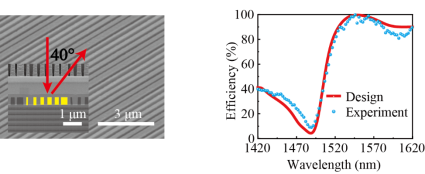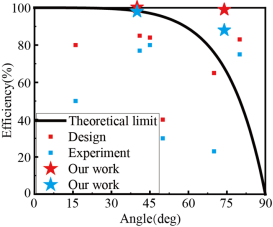Metasurfaces, two-dimensional metamaterials composed of planar artificial atoms in a specific macroscopic arrangement, can control the amplitude, phase, and polarization of light waves at subwavelength scales and have demonstrated powerful capabilities to manipulate light waves, such as anomalous deflections of light, dispersion compensation, metalens imaging, holographic imaging, and so forth. Metasurfaces have become a new platform for electromagnetic wave regulation due to its low loss, feasible fabrication and easy integration.
Although the excellent capabilities have been demonstrated, the efficiency of metasurfaces is a long-standing bottleneck issue that hinders practical and commercialized applications of meta-devices. Anomalous deflection (as shown in Figure 1) is one of the most fundamental functions of metasurfaces to control light and the basis for various complex light wave manipulations and applications, such as metalens, spectrometers, and LiDARs. At present, the anomalous deflection efficiency of optical meta-devices is lower than 90%, which is difficult to meet the requirement of high efficiency over 99% in laser applications. Hence, it is urgent to break through traditional understanding, innovate regulation methods, and obtain perfect anomalous reflectors at optical frequencies.

Figure 1. Normal deflection at uniform interfaces and anomalous deflection of metasurfaces
There are two stages to scientifically understand the anomalous deflection efficiency of metasurfaces: in early studies the direction of anomalous deflection is operated by phase gradient1, 2, while the amount of anomalous deflection is unknown, making it difficult to achieve perfect anomalous deflection with an efficiency close to 100%; recently, it is reported that perfect anomalous deflection requires a co-regulation of phase and amplitude3, 4 that needs simultaneous gain and loss in different regions of the metasurface. The perfect anomalous deflection at optical frequencies is an entirely new challenge and hasn’t been resolved.
Therefore, Professor Cheng Xinbin and Professor Wang Zhanshan from the School of Physical Science and Engineering of Tongji University and Professor Zhou Lei from the Department of Physics of Fudan University, proposed an all-dielectric quasi-three-dimensional subwavelength structure (Q3D-SWS), composed of a one-dimensional multilayer film and a two-dimensional metasurface, to clarify the energy flow distribution from the physical requirements of perfect anomalous reflection. A complex multiple scattering process was enhanced and the nonlocal control on light waves was improved by effectively coupling different Bloch waves and propagating waves in the Q3D-SWS, thus realizing the highest anomalous reflection efficiency at optical frequencies (over 99% at 1550nm) all over the world.
The result has been published in Science Advances with the title of "Perfect anomalous reflectors at optical frequencies". Professor Wang Zhanshan of Tongji University, Professor Zhou Lei of Fudan University, and Professor Cheng Xinbin of Tongji University are the co-corresponding authors of this paper. He Tao, a postdoctoral researcher of Tongji University, and Liu Tong, a doctoral student of Fudan University, are the co-authors of the paper. Professor Xiao Shiyi of Shanghai University, Associate Professor Wei Zeyong of Tongji University are collaborators who have made outstanding contributions to the paper.
From the physical requirements for perfect anomalous reflection, the requirements for the energy flow distribution are first given: we should suppress the second-order term of the energy flow distribution and match the first-order term at the same time (as shown in Figure 2). In a passive and lossless system without transmission, the desired energy flow distribution can be obtained via regulation the lateral energy flow in the system.

Figure 2. Requirements for the energy flow distribution to obtain perfect anomalous reflection
Traditional metal and dielectric metasurfaces are limited by absorption (transmission) loss and/or insufficient lateral energy-transfer capability, thus it is difficult to achieve perfect anomalous reflection. In this paper, a new quasi-three-dimensional subwavelength structure consisting of a one-dimensional multilayer film and a two-dimensional metasurface is demonstrated. Due to the interaction between the electromagnetic waves and the structure, the incident light is efficiently coupled into the Bloch waves inside the metasurface structure and the propagation waves into the spacer. The lateral energy-transfer capability of the whole system is enhanced by controlling the complex multiple scattering of electromagnetic waves at different orders, as shown in Figure 3. Further analysis of the field distributions shows that the lateral energy flow generated by the Bloch waves and the propagation waves can be regulated by reflection amplitudes and phases of the multilayer films, so as to achieve desired energy flow distribution.

Figure 3. Quasi-3D subwavelength structures to obtain perfect anomalous reflection: lateral energy flow modulation using amplitudes and phases of multilayer films
Taking 40° perfect anomalous reflection with normal incidence as an example, the design principle and methods of are introduced as follows. Considering that the phase requirement of 40° perfect anomalous reflection is still approximately linear and the transmission loss needs to be suppressed, a gradient metasurface and high-reflection films are chosen as initial structures, and on this basis the desired energy flow distribution can be achieved by changing phase responses ϕ0 and ϕ1 of the multilayer films. Therefore a Q3D-SWS structure with desired reflection amplitude and phase is designed, and anomalous reflection at optical frequencies with an efficiency over 99% is realized (Figure 4). Multilayer films are fabricated using a magnetron sputtering deposition system and the metasurface is fabricated using EBL, and the structure of the sample is shown in Figure 4, with its test anomalous reflection efficiency up to 98%. The experimental and theoretical designs are in good agreement, which also verifies the accuracy and reliability of the fabrication and test results.

Figure 4. SEM side-view image and cross-section image of the sample and the spectra measured in the experiment
The highest anomalous reflection efficiency at optical frequencies all over the world has been realized. In addition, a polarization-independent perfect anomalous reflection and a polarization-dependent mirror have been designed, which demonstrated the powerful ability to manipulate efficiency and the potential of quasi-3D subwavelength structures.

Figure 5. Comparison of anomalous reflection efficiencies at optical frequencies 5-10
Outlook
This work aim to the practical needs of optical metasurfaces, and solve the problem of low efficiency that limits its application. It is expected to promote the development of micro-spectrometers, LiDARs and other devices based on optical metasurfaces.
Information
He T, Liu T, Xiao S, Wei Z, Wang Z, Zhou L, et al. Perfect anomalous reflectors at optical frequencies. Sci. Adv. 2022, 8(9): eabk3381.
https://www.science.org/doi/10.1126/sciadv.abk3381
References
1. Yu N, Genevet P, Kats MA, Aieta F, Tetienne J-P, Capasso F, et al. Light Propagation with Phase Discontinuities: Generalized Laws of Reflection and Refraction. Science 2011, 334(6054): 333-337.
2. Sun S, He Q, Xiao S, Xu Q, Li X, Zhou L. Gradient-index meta-surfaces as a bridge linking propagating waves and surface waves. Nat Mater 2012, 11(5): 426-431.
3. Estakhri NM, Alu A. Wave-front Transformation with Gradient Metasurfaces. Phys. Rev. X 2016, 6(4): 041008.
4. Díaz-Rubio-Rubio A, Asadchy VS, Elsakka A, Tretyakov SA. From the generalized reflection law to the realization of perfect anomalous reflectors. Sci. Adv. 2017, 3(8): e1602714.
5. Pors A, Albrektsen O, Radko IP, Bozhevolnyi SI. Gap plasmon-based metasurfaces for total control of reflected light. Sci. Rep. 2013, 3(1): 1-6.
6. Li ZY, Palacios E, Butun S, Aydin K. Visible-Frequency Metasurfaces for Broadband Anomalous Reflection and High-Efficiency Spectrum Splitting. Nano Lett. 2015, 15(3): 1615-1621.
7. Sun S, Yang KY, Wang CM, Juan TK, Chen WT, Liao CY, et al. High-efficiency broadband anomalous reflection by gradient meta-surfaces. Nano Lett. 2012, 12(12): 6223-6229.
8. Gao S, Yue W, Park C-S, Lee S-S, Kim E-S, Choi D-Y. Aluminum Plasmonic Metasurface Enabling a Wavelength-Insensitive Phase Gradient for Linearly Polarized Visible Light. ACS Photonics 2017, 4(2): 322-328.
9. Gao S, Lee SS, Kim ES, Choi DY. Vertically integrated visible and near-infrared metasurfaces enabling an ultra-broadband and highly angle-resolved anomalous reflection. Nanoscale 2018, 10(26): 12453-12460.
10. Asadchy VS, Wickberg A, Diaz-Rubio A, Wegener M. Eliminating Scattering Loss in Anomalously Reflecting Optical Metasurfaces. ACS Photonics 2017, 4(5): 1264-1270.
